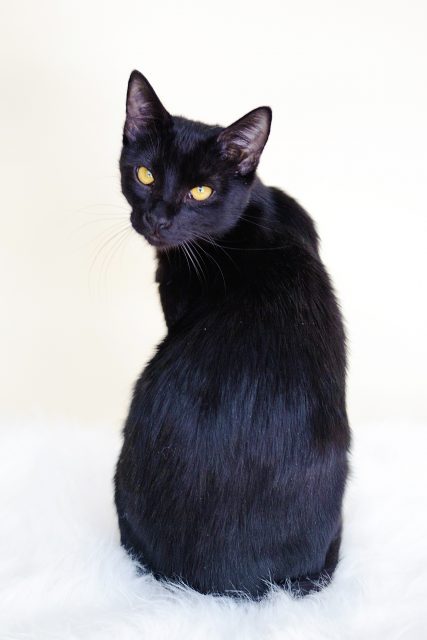Type the name of the breed you're looking for below
[wpdreams_ajaxsearchlite] Don't see the breed your're looking for? Click here and let us know!
Breed Characteristics
1 paw - breed exhibits the least amount of this characteristic
5 paws - breed exhibits most amount of this characteristic
Bombay
| Origin And History | The Bombay was created in the 1950s by the late Nikki Horner, an American breeder who wanted to develop a cat that possessed the conformation of the Burmese but with a sleek black coat and copper eyes instead of brown fur and yellow eyes, sort of a pint-sized panther. She named the breed after Bombay, India, land of the black leopard. She first attempted to breed a female Burmese to a black American Shorthair. The results were disappointing; they looked more like poor American Shorthairs than anything else. For her second try Horner chose her breeders and cats more carefully. She shopped around until she found a black American Shorthair male that had the rich eye color she wanted and bred him to one of her best Champion Burmese. After much trial and error, Horner finally produced the results she was looking for: a cat with the conformation and short polished coat of the Burmese, and the American Shorthair's copper-colored eyes and black color. Creating a breed, even one as striking as the Bombay, doesn't mean cat fancy acceptance, however. Horner found that the Burmese breeders and the cat associations weren't overly willing to accept her new kid on the block. Since the breed had not been accepted for Championship, Horner had no Champion cats with which to catch the attention of the cat-acquiring public. It wasn't until 1970 that the breed was accepted for registration by the CFA. Advancing from registration to provisional status meant Horner had to form at least one breed club and register 100 examples of the breed. Eighteen years after Horner began her efforts, the breed gained eligibility to compete in the Championship classes on May 1, 1976. While still currently rare (in 1996, the CFA registered only 91), the breed has a dedicated following. |
| Personality | The Bombay is a highly social breed that loves to be in the company of others. Bombays tend to be attached to their families and crave attention, and for this reason this breed is highly suitable for children. Most Bombay cats are not independent. Older Bombays are somewhat more independent than younger ones. They seek attention from their owners and people around them often and dislike being left alone for extended periods of time. Although they like to be around people generally, Bombay Cats also tend to have a certain person whom they pay special attention to in their lives. Overall, the Bombay breed is intelligent, playful, and attention-seeking.They tend to get along well with other cats, as they have an established pecking order in the household. They have a very distinctive purr and love to snuggle. |
Physical Attributes
| Appearance | Black to the roots, the Bombay's coat invites caressing with its fine, satinlike texture and shimmering 'patent leather' sheen. Bombays develop slowly, gaining their eye color and gleaming coat well after they are four months old. Some prospective buyers tend to think the kittens look rather ordinary. |
| Health | All cats have the potential to develop genetic health problems, just as all people have the potential to inherit diseases. Any breeder who claims that her breed has no health or genetic problems is either lying or is not knowledgeable about the breed. Run, don’t walk, from any breeder who does not offer a health guarantee on kittens, who tells you that the breed is 100 percent healthy and has no known problems, or who tells you that her kittens are isolated from the main part of the household for health reasons. The Bombay is generally healthy, but some of the problems that affect the breed hypertrophic cardiomyopathy, excessive tearing of the eyes, and the possibility of breathing difficulties because of the cat’s short muzzle. Hypertrophic cardiomyopathy (HCM) is the most common form of heart disease in cats. It causes thickening (hypertrophy) of the heart muscle. An echocardiogram can confirm whether a cat has HCM. Avoid breeders who claim to have HCM-free lines. No one can guarantee that their cats will never develop HCM. Bombays that will be bred should be screened for HCM, and cats identified with HCM should be removed from breeding programs. Do not buy a kitten whose parents have not been tested for this disease. It is always wise to buy from a breeder who provides a written health guarantee. |



